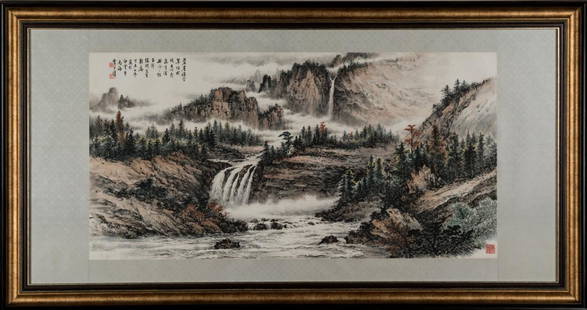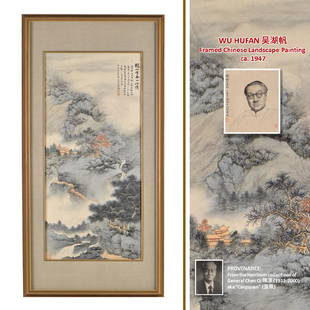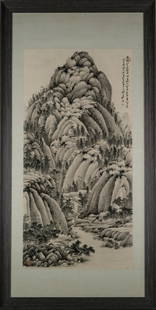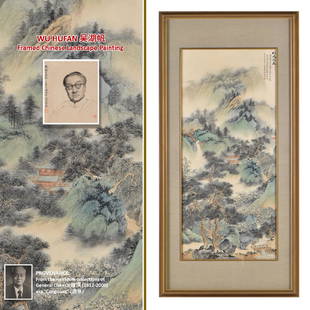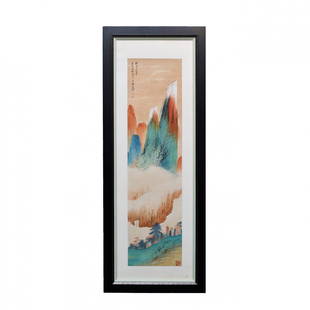
HUANG JUNBI, FRAMED LANDSCAPE PAINTING, CA. 1949
Similar Sale History
View More Items in PaintingsRelated Paintings
More Items in Chinese Paintings
View MoreRecommended Art
View More














Item Details
Description
Huang JunBi 黄君璧 (1898-1991), painted in Autumn of Ji Chou year, 1949. Chinese landscape of ink and color on paper, depicting a waterfall landscape within misty mountainous scene. Showing themed calligraphy inscriptions, followed by artist's iron-red signature seals on left. Mounted on gayish silk border, set behind glass and wooden box framed.
Every characteristic feature of a country landscape is held by the Chinese artist to correspond to phases of the human soul; water is thus regarded as the blood of the mountain, grass and trees their hair, mist and clouds their coloring; mountains are considered to be the face of the waters, houses and fences its eyebrows and eyes, while the retired scholar represents the spirit of his rustic surroundings.
Chinese works on drawings give detailed directions for representing every kind of scenery, creates wonderful effects with only few strokes of the brush. Mountains and stream are described as the highest objects for the painter’s skill, how to depict their beauties under every varying circumstance of season and weather.
The ideal mountain have a cloud encircling its ‘waist’, which hide from view part of the stream which pour over rocks and waterfalls down its sides, and water appear as though ruffled by wind.
The boughs of a tree having supple leaves, pine bark drawn as fishes’ scales, with left branches longer than those on the right, the rocks are heavy above and slight beneath.
The proportion is well balanced, there never be too much smoke or cloud, nor have too many trees.
The portion of the sale will benefit a local church in Atlanta area.
Dimension: 37" H x 72" W
PROVENANCE:
From the collection of General Chen Qi 陳淇; (1912-2000), who styled himself as “Cangquan” (滄泉and “Yuquanshanren”玉泉山人), an artist, calligrapher, a prominent businessman and private antiques collector.
EDEN Fine Antiques Galleries is honored and proud to offer, once again, to be the last General Chen Qi's heirloom collections including unpublished painting from Zhang DaQian, Fu BaoShi, Qi BaiShi, Huang JunBi, Wu ChangShuo, Xu BeiHong, Dong ShouPing, Dong BangDa 董邦达, Li XiongCai, and many other famous artists; along with his extraordinary Chinese porcelain collections.
General Chen Qi's collections can be found on Lot-128 through Lot-161 (Day 1), continuing at Lot-402 through Lot-423 (Day 2).
For more information about General Chen Qi's Biography, please refer to this link:
http://chen-qi.net/
https://en.wikipedia.org/wiki/Chen_Qi_(collector)
Chen Qi (陳淇;), who styled himself as “Cangquan” (滄泉and “Yuquanshanren”玉泉山人), is a modern collector.
Chen Qi was born in Fujian on March 8, 1912 in a merchant family. He was well educated in traditional culture since childhood. Chen Qi began to learn literacy from his grandfather since 1916, and had studied enlightenment readings such as Three Character Classic, Thousand Poems, Book of Filial Piety, and Confucian classics, etc.. He also studied Tang Kai (one of the Chinese traditional calligraphy scripts originated from Tang Dynasty) as daily calligraphy class.
In 1927, Chen Qi was enrolled in a Christian school.
In 1928, Chen Qi dropped out of school due to illness. While recuperating at home, he read books and newspapers, and gained a deeper understanding from his communications with businessmen from the South of the devastated and weakened old Chinese society. Just like other youths full with aspirations in the turbulent time, Chen Qi determined to transform China and save Chinese people from the crisis.
In 1932, Chen Qi went to Japan and was enrolled in the famous Imperial Japanese Army Academy, a military school founded in 1868. Imperial Japanese Army Academy was committed to Militaristic Spiritual Education and had successfully trained a large number of senior generals participated in the war of aggression again China later on. Many famous modern Chinese generals also graduated from Imperial Japanese Army Academy, such as Cai E, Ying Heqin, Li Rujiong, Tang Enbo, etc.
While Chen Qi was in Japan, he not only met his wife, Qiuben Jiumeizi, who accompanied him by a lifetime (moved to China with Chen Qi later on and changed her name to Lin Yachun), in May 1935, he also got to know Chinese painter, Fu Baoshi, who was holding a Exhibition at the time. It was the first exhibition Fu Baoshi held in Japan. Both staying in foreign country, the two became friends right away. In June of the same year, Fu Baoshi went back to China due to his mother's serious illness (his mother already passed away after his return). Two months later, Chen Qi returned to China as well and was invited by Fu Baoshi to visit Nan Chang, where Fu held his first personal exhibition in China.
In 1935, Chen Qi was appointed by National Revolutionary Army to teach in Republic of China Military Academy, also known as Huangpu Military Academy. He became Deputy Director of Training and was granted the rank of Major General. During his tenure, he had made great contribution through training of military personnel. Just like what the founder of modern China, Sun Zhongshan, had said, we found this school to lead the students to become the foundation of revolutionary army. You will be the future elites of revolutionary army. And this is the way that lead to our success in revolution.
During his term as director, Chen Qi developed extensive social contacts not only in politics, but also in business, literary and art circles. He also concentrated in calligraphy, reading and painting.
In January 1936 (the 25th year of the Republic Era), Chen Qi went to Tianjin (original destination was Beijing but stayed in Tianjin for a few days) to attend an exhibition in Tianjin Yong'An Restaurant, held by a group of painters including Zhang Daqian, Zhang Shanzi, Xiao Qianzhong, Hu Peiheng, Xu Yansun, Yu FeiAn, He Haixia, etc.. During the trip, besides political and business affairs, Chen Qi had made contacts with celebrities in literary and art circles, including Mei Lanfang and Qi Baishi.
Although working in military during the turbulent time, Chen Qi was still deeply affected by Confucianism and traditional cultural education he received since childhood. He continued studying in painting and focused on collection of various arts and antiques from various Chinese Dynasties.
In 1955, after arriving at Taiwan, Chen Qi was appointed as military official of the embassy in Indonesia. He attended multiple international affairs and meetings on behalf of Nationalist Government (Guomin Government), and often travelled between Taiwan and Indonesia due to business and political reasons. In Taiwan, he had close personal relationships with Pu Xinyu, Zhang Daqian, Huang Junbi, Xu Fuguan, Hu Shi, and Yu Youren, etc.. He was also a frequent guest of Jiang Jieshi and Song Meiling.
During his work in Indonesia, Chen Qi got to know Chinese painters such as Wu Zishen and Yan Wanyu, and built close personal relationship with them. They often send each other letters and poems to maintain contacts.
In 1965, Chen Qi left his job in Indonesia, and travelled frequently to mainland China during the 80s. He was generous and made multiple contributions to nonprofit programs and organizations in his homeland, including building schools, water conservation, and newspaper industry. Meanwhile, he continued studying calligraphy, especially during his old age, and enjoyed simple life.
LOT NOTES:
Huang Junbi 黄君璧 was born in the then town of Nanhai, which is now a district of Guangzhou city. His talent for drawing and painting was formidable from a young age. He began studying classical Chinese painting from the master artist Li Yaoping when he was 22. Yaoping taught Huang in the traditional way, with strict obedience to the master and hours of copying masterpieces.
The study of Occidental art was encouraged by the Chinese government at this time, and Huang himself was most interested in learning about the styles and techniques. So he joined the Chu-Ting Art School that taught Western painting in 1922.
Huang joined the Gui Hai Painting Cooperative that had been formed by Deng Fen in Guangzhou in 1923. A few years later, in 1929, he became one of the co-founders of the Yue Society in the city. He concentrated on making landscapes during these years, and it was the intermingling of Western and Chinese styles that made his art quite unique at the time. His work was becoming more and more popular, and he was appointed to teach at the Chinese Painting Research Society in 1932. This was the beginning of a long teaching career.
In 1934, the Guangzhou municipal government decided to send Huang to Japan with the aim of learning art education. A few years later, he moved to Sichuan, and was appointed head of the Chinese Painting Department in Chongqing in 1942.
Huang decided to leave Mainland China in 1949, and moved to the newly created Republic of China, namely Taiwan. It was here that he really came into his own as an artist. He was immediately hired to teach at the National Taiwan Normal University when he arrived, and was a co-founder of the Department of Fine Arts of which he was the director for more than two decades.
Huang believed in training teachers in order to have better students. He spent a lot of time and effort in making sure that the quality of the teachers at the university was excellent, and academic research was encouraged. He had a system of five steps for teaching. It started with demonstrating personally what one wanted, followed by showing works to the students who were then given detailed explanations of the work they were being shown. The students were then expected to make their own sketches, and finally they were encouraged to be creative and innovative in their work.
Apart from teaching, Huang painted prolifically. According to his daughter, the artist Huang Xiangling, he painted every single day, and worked extremely hard for both the university and his students.
The Later Years
In 1957, Huang travelled to the United States for the first time. Three years later, he was invited to visit again, this time as a Fellow of the Brazil Arts Institute based in Houston, where he spent several months. He made a third trip in 1966, and a last one in 1969.
Huang retired from teaching sometime in the early 1970s, by which time he himself was more than 70 years old. The artist fell ill and died in Taipei in 1991.
Every characteristic feature of a country landscape is held by the Chinese artist to correspond to phases of the human soul; water is thus regarded as the blood of the mountain, grass and trees their hair, mist and clouds their coloring; mountains are considered to be the face of the waters, houses and fences its eyebrows and eyes, while the retired scholar represents the spirit of his rustic surroundings.
Chinese works on drawings give detailed directions for representing every kind of scenery, creates wonderful effects with only few strokes of the brush. Mountains and stream are described as the highest objects for the painter’s skill, how to depict their beauties under every varying circumstance of season and weather.
The ideal mountain have a cloud encircling its ‘waist’, which hide from view part of the stream which pour over rocks and waterfalls down its sides, and water appear as though ruffled by wind.
The boughs of a tree having supple leaves, pine bark drawn as fishes’ scales, with left branches longer than those on the right, the rocks are heavy above and slight beneath.
The proportion is well balanced, there never be too much smoke or cloud, nor have too many trees.
The portion of the sale will benefit a local church in Atlanta area.
Dimension: 37" H x 72" W
PROVENANCE:
From the collection of General Chen Qi 陳淇; (1912-2000), who styled himself as “Cangquan” (滄泉and “Yuquanshanren”玉泉山人), an artist, calligrapher, a prominent businessman and private antiques collector.
EDEN Fine Antiques Galleries is honored and proud to offer, once again, to be the last General Chen Qi's heirloom collections including unpublished painting from Zhang DaQian, Fu BaoShi, Qi BaiShi, Huang JunBi, Wu ChangShuo, Xu BeiHong, Dong ShouPing, Dong BangDa 董邦达, Li XiongCai, and many other famous artists; along with his extraordinary Chinese porcelain collections.
General Chen Qi's collections can be found on Lot-128 through Lot-161 (Day 1), continuing at Lot-402 through Lot-423 (Day 2).
For more information about General Chen Qi's Biography, please refer to this link:
http://chen-qi.net/
https://en.wikipedia.org/wiki/Chen_Qi_(collector)
Chen Qi (陳淇;), who styled himself as “Cangquan” (滄泉and “Yuquanshanren”玉泉山人), is a modern collector.
Chen Qi was born in Fujian on March 8, 1912 in a merchant family. He was well educated in traditional culture since childhood. Chen Qi began to learn literacy from his grandfather since 1916, and had studied enlightenment readings such as Three Character Classic, Thousand Poems, Book of Filial Piety, and Confucian classics, etc.. He also studied Tang Kai (one of the Chinese traditional calligraphy scripts originated from Tang Dynasty) as daily calligraphy class.
In 1927, Chen Qi was enrolled in a Christian school.
In 1928, Chen Qi dropped out of school due to illness. While recuperating at home, he read books and newspapers, and gained a deeper understanding from his communications with businessmen from the South of the devastated and weakened old Chinese society. Just like other youths full with aspirations in the turbulent time, Chen Qi determined to transform China and save Chinese people from the crisis.
In 1932, Chen Qi went to Japan and was enrolled in the famous Imperial Japanese Army Academy, a military school founded in 1868. Imperial Japanese Army Academy was committed to Militaristic Spiritual Education and had successfully trained a large number of senior generals participated in the war of aggression again China later on. Many famous modern Chinese generals also graduated from Imperial Japanese Army Academy, such as Cai E, Ying Heqin, Li Rujiong, Tang Enbo, etc.
While Chen Qi was in Japan, he not only met his wife, Qiuben Jiumeizi, who accompanied him by a lifetime (moved to China with Chen Qi later on and changed her name to Lin Yachun), in May 1935, he also got to know Chinese painter, Fu Baoshi, who was holding a Exhibition at the time. It was the first exhibition Fu Baoshi held in Japan. Both staying in foreign country, the two became friends right away. In June of the same year, Fu Baoshi went back to China due to his mother's serious illness (his mother already passed away after his return). Two months later, Chen Qi returned to China as well and was invited by Fu Baoshi to visit Nan Chang, where Fu held his first personal exhibition in China.
In 1935, Chen Qi was appointed by National Revolutionary Army to teach in Republic of China Military Academy, also known as Huangpu Military Academy. He became Deputy Director of Training and was granted the rank of Major General. During his tenure, he had made great contribution through training of military personnel. Just like what the founder of modern China, Sun Zhongshan, had said, we found this school to lead the students to become the foundation of revolutionary army. You will be the future elites of revolutionary army. And this is the way that lead to our success in revolution.
During his term as director, Chen Qi developed extensive social contacts not only in politics, but also in business, literary and art circles. He also concentrated in calligraphy, reading and painting.
In January 1936 (the 25th year of the Republic Era), Chen Qi went to Tianjin (original destination was Beijing but stayed in Tianjin for a few days) to attend an exhibition in Tianjin Yong'An Restaurant, held by a group of painters including Zhang Daqian, Zhang Shanzi, Xiao Qianzhong, Hu Peiheng, Xu Yansun, Yu FeiAn, He Haixia, etc.. During the trip, besides political and business affairs, Chen Qi had made contacts with celebrities in literary and art circles, including Mei Lanfang and Qi Baishi.
Although working in military during the turbulent time, Chen Qi was still deeply affected by Confucianism and traditional cultural education he received since childhood. He continued studying in painting and focused on collection of various arts and antiques from various Chinese Dynasties.
In 1955, after arriving at Taiwan, Chen Qi was appointed as military official of the embassy in Indonesia. He attended multiple international affairs and meetings on behalf of Nationalist Government (Guomin Government), and often travelled between Taiwan and Indonesia due to business and political reasons. In Taiwan, he had close personal relationships with Pu Xinyu, Zhang Daqian, Huang Junbi, Xu Fuguan, Hu Shi, and Yu Youren, etc.. He was also a frequent guest of Jiang Jieshi and Song Meiling.
During his work in Indonesia, Chen Qi got to know Chinese painters such as Wu Zishen and Yan Wanyu, and built close personal relationship with them. They often send each other letters and poems to maintain contacts.
In 1965, Chen Qi left his job in Indonesia, and travelled frequently to mainland China during the 80s. He was generous and made multiple contributions to nonprofit programs and organizations in his homeland, including building schools, water conservation, and newspaper industry. Meanwhile, he continued studying calligraphy, especially during his old age, and enjoyed simple life.
LOT NOTES:
Huang Junbi 黄君璧 was born in the then town of Nanhai, which is now a district of Guangzhou city. His talent for drawing and painting was formidable from a young age. He began studying classical Chinese painting from the master artist Li Yaoping when he was 22. Yaoping taught Huang in the traditional way, with strict obedience to the master and hours of copying masterpieces.
The study of Occidental art was encouraged by the Chinese government at this time, and Huang himself was most interested in learning about the styles and techniques. So he joined the Chu-Ting Art School that taught Western painting in 1922.
Huang joined the Gui Hai Painting Cooperative that had been formed by Deng Fen in Guangzhou in 1923. A few years later, in 1929, he became one of the co-founders of the Yue Society in the city. He concentrated on making landscapes during these years, and it was the intermingling of Western and Chinese styles that made his art quite unique at the time. His work was becoming more and more popular, and he was appointed to teach at the Chinese Painting Research Society in 1932. This was the beginning of a long teaching career.
In 1934, the Guangzhou municipal government decided to send Huang to Japan with the aim of learning art education. A few years later, he moved to Sichuan, and was appointed head of the Chinese Painting Department in Chongqing in 1942.
Huang decided to leave Mainland China in 1949, and moved to the newly created Republic of China, namely Taiwan. It was here that he really came into his own as an artist. He was immediately hired to teach at the National Taiwan Normal University when he arrived, and was a co-founder of the Department of Fine Arts of which he was the director for more than two decades.
Huang believed in training teachers in order to have better students. He spent a lot of time and effort in making sure that the quality of the teachers at the university was excellent, and academic research was encouraged. He had a system of five steps for teaching. It started with demonstrating personally what one wanted, followed by showing works to the students who were then given detailed explanations of the work they were being shown. The students were then expected to make their own sketches, and finally they were encouraged to be creative and innovative in their work.
Apart from teaching, Huang painted prolifically. According to his daughter, the artist Huang Xiangling, he painted every single day, and worked extremely hard for both the university and his students.
The Later Years
In 1957, Huang travelled to the United States for the first time. Three years later, he was invited to visit again, this time as a Fellow of the Brazil Arts Institute based in Houston, where he spent several months. He made a third trip in 1966, and a last one in 1969.
Huang retired from teaching sometime in the early 1970s, by which time he himself was more than 70 years old. The artist fell ill and died in Taipei in 1991.
Condition
Over all in EXCELLENT Condition. Natural imperfection on the medium (paper or silk), regardless from any major damages; includes light blooms, discoloration and minor fading. Consider normal due to the ages.
The bidder assumes responsibility for ensuring that the condition of the item(s) meets with their satisfaction prior to bidding. Any condition statement is given as a courtesy to a client, and is only an opinion and should not be treated as a statement of fact. EDEN Galleries shall have no responsibility for any error or omission. The absence of a condition statement does not imply that the lot is in perfect condition or completely free from wear and tear, imperfections or the effects of aging.
The bidder assumes responsibility for ensuring that the condition of the item(s) meets with their satisfaction prior to bidding. Any condition statement is given as a courtesy to a client, and is only an opinion and should not be treated as a statement of fact. EDEN Galleries shall have no responsibility for any error or omission. The absence of a condition statement does not imply that the lot is in perfect condition or completely free from wear and tear, imperfections or the effects of aging.
Buyer's Premium
- 25% up to $100,000.00
- 20% up to $1,000,000.00
- 15% above $1,000,000.00
HUANG JUNBI, FRAMED LANDSCAPE PAINTING, CA. 1949
Estimate $3,000 - $5,000
13 bidders are watching this item.
Shipping & Pickup Options
Item located in Marietta, GA, usSee Policy for Shipping
Payment
Accepts seamless payments through LiveAuctioneers

TOP
















